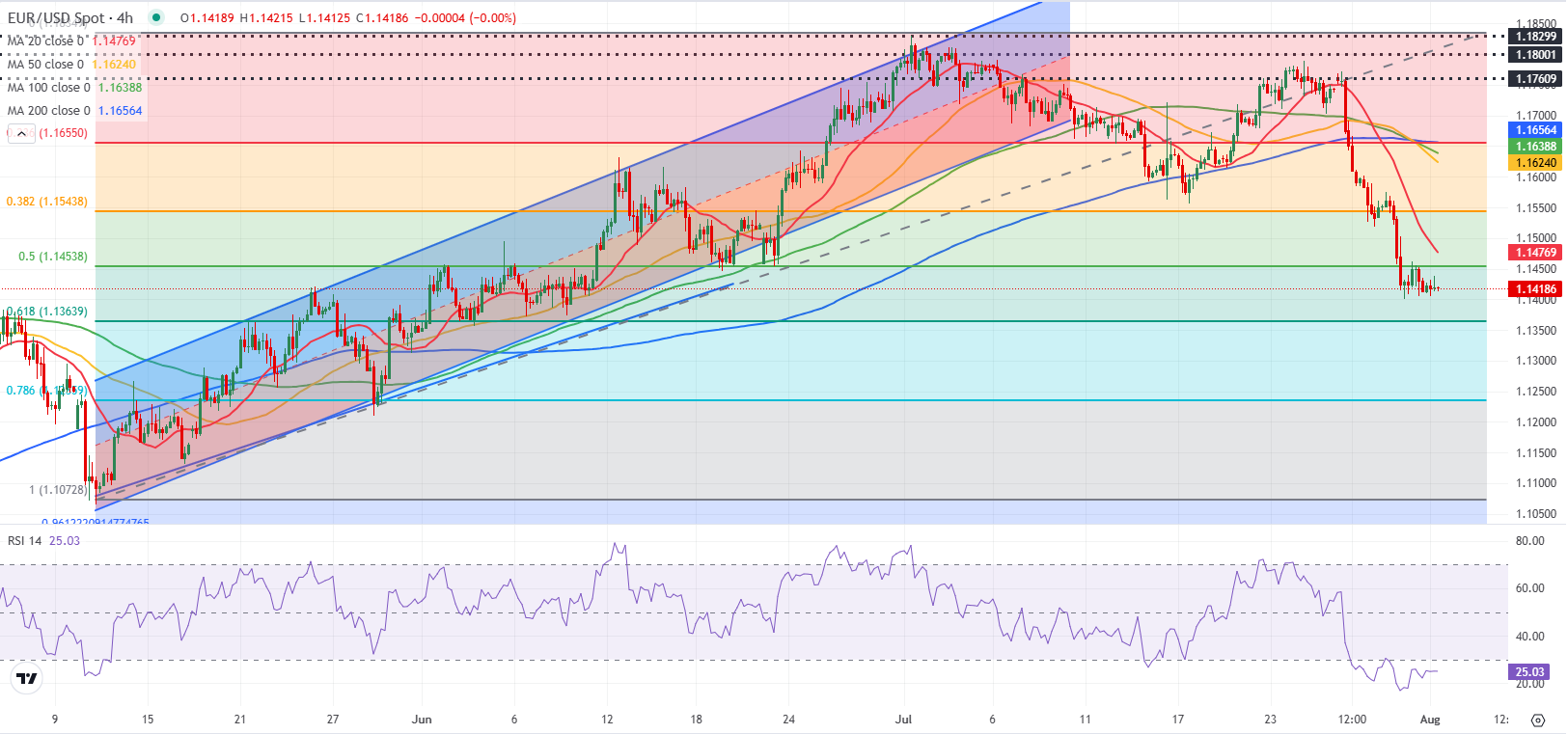- EUR/USD consolidates weekly losses, trades slightly above 1.1400.
- Markets expect Nonfarm Payrolls to rise 110,000 in July.
- The technical outlook suggests that the pair remains technically oversold.
After suffering heavy losses in the first half of the week, EUR/USD found support on Thursday and closed the day virtually unchanged. The pair fluctuates in a narrow range above 1.1400 as investors remain on the sidelines while waiting for the July employment report from the US.
Euro PRICE This week
The table below shows the percentage change of Euro (EUR) against listed major currencies this week. Euro was the weakest against the US Dollar.
| USD | EUR | GBP | JPY | CAD | AUD | NZD | CHF | |
|---|---|---|---|---|---|---|---|---|
| USD | 2.97% | 1.90% | 1.88% | 1.18% | 2.31% | 2.54% | 2.32% | |
| EUR | -2.97% | -1.07% | -1.03% | -1.74% | -0.64% | -0.42% | -0.64% | |
| GBP | -1.90% | 1.07% | -0.16% | -0.68% | 0.44% | 0.65% | 0.44% | |
| JPY | -1.88% | 1.03% | 0.16% | -0.68% | 0.38% | 0.62% | 0.58% | |
| CAD | -1.18% | 1.74% | 0.68% | 0.68% | 1.08% | 1.34% | 1.12% | |
| AUD | -2.31% | 0.64% | -0.44% | -0.38% | -1.08% | 0.22% | -0.01% | |
| NZD | -2.54% | 0.42% | -0.65% | -0.62% | -1.34% | -0.22% | -0.22% | |
| CHF | -2.32% | 0.64% | -0.44% | -0.58% | -1.12% | 0.00% | 0.22% |
The heat map shows percentage changes of major currencies against each other. The base currency is picked from the left column, while the quote currency is picked from the top row. For example, if you pick the Euro from the left column and move along the horizontal line to the US Dollar, the percentage change displayed in the box will represent EUR (base)/USD (quote).
Following the rally that was fuelled by the Federal Reserve’s (Fed) hawkish tone and upbeat macroeconomic data releases, the US Dollar (USD) struggled to preserve its bullish momentum late Thursday. The US President Donald Trump’s decision to raise the tariff rate on Canadian imports to 35% from 25% seems to have caused investors to take a step back before adding to long positions for the USD.
Later in the day, the US Bureau of Labor Statistics (BLS) will publish the employment report for July. Nonfarm Payrolls (NFP) are forecast to rise 110,000 and the Unemployment Rate is expected to tick up to 4.2% from 4.1%.
A positive surprise in NFP, combined with an Unemployment Rate print of 4.1% or lower, could feed into expectations for a Fed rate hold at the September meeting and boost the USD heading into the weekend. On the other hand, a weak NFP reading of 90,000, or lower, could keep the hopes of a September rate cut alive and trigger a USD selloff with the immediate reaction.
According to the CME FedWatch Tool, markets are currently pricing in about 40% probability of the Fed lowering the policy rate by 25 basis points at the next policy meeting.
EUR/USD Technical Analysis

The Relative Strength Index (RSI) indicator on the 4-hour chart moves sideways below 30, suggesting that the pair remains technically overbought. Nevertheless, investors could ignore technical conditions when reacting to the NFP data.
On the downside, interim support seems to have formed at 1.1400 (static level) before 1.1360 (Fibonacci 61.8% retracement of the latest uptrend) and 1.1300 (static level, round level). Looking north, resistance levels could be seen at 1.1450 (Fibonacci 50% retracement), 1.1500 (static level, round level) and 1.1540 (Fibonacci 38.2% retracement).
Nonfarm Payrolls FAQs
Nonfarm Payrolls (NFP) are part of the US Bureau of Labor Statistics monthly jobs report. The Nonfarm Payrolls component specifically measures the change in the number of people employed in the US during the previous month, excluding the farming industry.
The Nonfarm Payrolls figure can influence the decisions of the Federal Reserve by providing a measure of how successfully the Fed is meeting its mandate of fostering full employment and 2% inflation. A relatively high NFP figure means more people are in employment, earning more money and therefore probably spending more. A relatively low Nonfarm Payrolls’ result, on the either hand, could mean people are struggling to find work. The Fed will typically raise interest rates to combat high inflation triggered by low unemployment, and lower them to stimulate a stagnant labor market.
Nonfarm Payrolls generally have a positive correlation with the US Dollar. This means when payrolls’ figures come out higher-than-expected the USD tends to rally and vice versa when they are lower. NFPs influence the US Dollar by virtue of their impact on inflation, monetary policy expectations and interest rates. A higher NFP usually means the Federal Reserve will be more tight in its monetary policy, supporting the USD.
Nonfarm Payrolls are generally negatively-correlated with the price of Gold. This means a higher-than-expected payrolls’ figure will have a depressing effect on the Gold price and vice versa. Higher NFP generally has a positive effect on the value of the USD, and like most major commodities Gold is priced in US Dollars. If the USD gains in value, therefore, it requires less Dollars to buy an ounce of Gold. Also, higher interest rates (typically helped higher NFPs) also lessen the attractiveness of Gold as an investment compared to staying in cash, where the money will at least earn interest.
Nonfarm Payrolls is only one component within a bigger jobs report and it can be overshadowed by the other components. At times, when NFP come out higher-than-forecast, but the Average Weekly Earnings is lower than expected, the market has ignored the potentially inflationary effect of the headline result and interpreted the fall in earnings as deflationary. The Participation Rate and the Average Weekly Hours components can also influence the market reaction, but only in seldom events like the “Great Resignation” or the Global Financial Crisis.
Information on these pages contains forward-looking statements that involve risks and uncertainties. Markets and instruments profiled on this page are for informational purposes only and should not in any way come across as a recommendation to buy or sell in these assets. You should do your own thorough research before making any investment decisions. FXStreet does not in any way guarantee that this information is free from mistakes, errors, or material misstatements. It also does not guarantee that this information is of a timely nature. Investing in Open Markets involves a great deal of risk, including the loss of all or a portion of your investment, as well as emotional distress. All risks, losses and costs associated with investing, including total loss of principal, are your responsibility. The views and opinions expressed in this article are those of the authors and do not necessarily reflect the official policy or position of FXStreet nor its advertisers. The author will not be held responsible for information that is found at the end of links posted on this page.
If not otherwise explicitly mentioned in the body of the article, at the time of writing, the author has no position in any stock mentioned in this article and no business relationship with any company mentioned. The author has not received compensation for writing this article, other than from FXStreet.
FXStreet and the author do not provide personalized recommendations. The author makes no representations as to the accuracy, completeness, or suitability of this information. FXStreet and the author will not be liable for any errors, omissions or any losses, injuries or damages arising from this information and its display or use. Errors and omissions excepted.
The author and FXStreet are not registered investment advisors and nothing in this article is intended to be investment advice.







